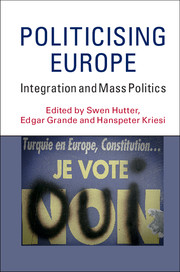Book contents
- Frontmatter
- Contents
- List of figures
- List of tables
- List of contributors
- Preface and acknowledgements
- Part I Theory and methods
- 1 Introduction: European integration and the challenge of politicisation
- 2 Exploring politicisation: design and methods
- Part II Mapping the politicisation of European integration
- Part III Driving forces and consequences of politicisation
- Part IV Conclusions
- Methodological Appendix: measuring politicisation, benchmarks and data
- Bibliography
- Index
2 - Exploring politicisation: design and methods
from Part I - Theory and methods
Published online by Cambridge University Press: 05 March 2016
- Frontmatter
- Contents
- List of figures
- List of tables
- List of contributors
- Preface and acknowledgements
- Part I Theory and methods
- 1 Introduction: European integration and the challenge of politicisation
- 2 Exploring politicisation: design and methods
- Part II Mapping the politicisation of European integration
- Part III Driving forces and consequences of politicisation
- Part IV Conclusions
- Methodological Appendix: measuring politicisation, benchmarks and data
- Bibliography
- Index
Summary
Introduction
As stated in the Introduction, this study is mostly based on new original data which has been collected by a collaborative team of researchers for the purposes of this book. It represents the most comprehensive and ambitious effort thus far to analyse the politicisation of Europe in all its relevant manifestations over a long period of time in a large number of European countries. More precisely, the volume focuses on six western European countries – Austria, Britain, France, Germany, Sweden and Switzerland – in the period from the early 1970s to 2012, including very critical phases of the euro crisis.
Analysing the politicisation of European integration in such a comprehensive way entails confronting several conceptual and methodological challenges. The first challenge is the proper conceptualisation and demarcation of European integration, i.e., getting hold of Europe. The second challenge is designing an adequate research strategy which allows political conflict on European issues to be observed. The third is choosing the most appropriate methods to collect data on the politicisation of Europe. The final challenge of our study is determining meaningful levels of analysis and categorisations of issues when analysing the data on the politicisation of Europe.
In the following, we explain how we cope with each of these challenges. We describe in detail the critical choices we had to make in the design of our study, and in our strategy for collecting and analysing data. In the first section, we present our conceptualisation of European integration, its dimensions, its historical development and its country-specific manifestations. Against this background, we explain the periods covered by our study in more detail and the selection of countries. In the second section we introduce the three ‘windows’ that we use to observe the politicisation of Europe: (i) public debates on major integration steps, (ii) national election campaigns, and (iii) Europeanised protest events. In the third section, we introduce our data sources, sampling strategies, and coding procedures. We close by describing two central features of our data analysis, namely, the various levels of analysis we use and the categorisation of key variables. A more detailed account of how we measure politicisation can be found in the Methodological Appendix at the end of the volume.
- Type
- Chapter
- Information
- Politicising EuropeIntegration and Mass Politics, pp. 32 - 60Publisher: Cambridge University PressPrint publication year: 2016
- 9
- Cited by



